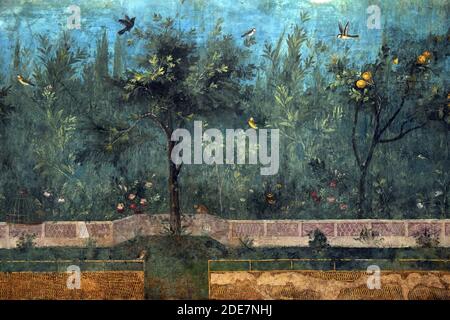

There had been no shortage of scholars of antiquity in previous centuries who, finding mention of the villa in written sources, wondered about their location, which was, however, only precisely identified in 1828, near the Prima Porta crossroads. It is also known as “Villa ad Gallinas Albas,” that is, “to the white hens”: the legend, recounted by Suetonius, says that, after her marriage to Augustus, Livia saw an eagle pass through Veio that laid a hen in her lap bearing a laurel sprig in its beak: Livia interpreted this as a good omen, and decided to raise the bird, giving birth to chicks. Livia’s villa was discovered only in the 19th century. They are one of the pinnacles of Roman painting. They inspire calm, serenity, tranquility, urging a contemplative dimension. They depict, seamlessly, a lush garden described with a great sense of realism: there are trees and fruit plants described in great detail, flowers, shrubs, birds fluttering and wandering among the branches and on the lawn, a fence and a marble balustrade. The frescoes, although fragmentary and partly ruined (we are still talking about works from two thousand years ago), have been preserved on all four walls. These are the extraordinary frescoes of the underground hall of the Villa of Livia Drusilla, third wife of Augustus, which were once located in her Villa at Prima Porta, a neighborhood on the northern outskirts of Rome.

One of the pinnacles of ancient Roman painting is preserved at the National Roman Museum, in the Palazzo Massimo building: the viridarium of Livia, a splendid frescoed garden from 30-20 BC from the villa of Augustus' wife.Īll those who visit the National Roman Museum for the first time at the site of the Palazzo Massimo alle Terme, just across the street from Roma Termini station, can hardly hold back their amazement when, in the halls of the paintings, towards the end of the tour they come across a splendid frescoed garden from the first century B.C., excellently preserved.


 0 kommentar(er)
0 kommentar(er)
